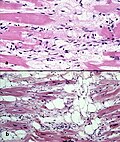Antiarrhythmic agents, also known as cardiac dysrhythmia medications, are a class of drugs that are used to suppress abnormally fast rhythms (tachycardias)... 20 KB (1,993 words) - 04:31, 21 February 2024 |
Sodium channel blocker (section Antiarrhythmic) Vaughan Williams classification. Class I antiarrhythmic agents interfere with the (Na+) channel. Class I agents are grouped by their effect on the Na+ channel... 11 KB (1,207 words) - 12:44, 8 November 2023 |
 | Quinidine (category Antiarrhythmic agents) Quinidine is a class IA antiarrhythmic agent used to treat heart rhythm disturbances. It is a diastereomer of antimalarial agent quinine, originally derived... 19 KB (1,862 words) - 01:53, 8 April 2024 |
observed. Dofetilide Ibutilide Ibutilide differs from other class III antiarrhythmic agents in that it activates the slow, delayed inward sodium channels rather... 17 KB (2,162 words) - 12:47, 28 April 2024 |
 | Lidocaine (category Antiarrhythmic agents) use in those allergic to tetracaine or benzocaine. Lidocaine is an antiarrhythmic medication of the class Ib type. This means it works by blocking sodium... 48 KB (4,424 words) - 22:39, 20 April 2024 |
 | Sparteine (category Antiarrhythmic agents) Sparteine is a class 1a antiarrhythmic agent and sodium channel blocker. It is an alkaloid and can be extracted from scotch broom. It is the predominant... 10 KB (849 words) - 02:24, 10 March 2024 |
 | Dofetilide is a class III antiarrhythmic agent. It is marketed under the trade name Tikosyn by Pfizer, and is available in the United States in capsules... 12 KB (1,255 words) - 07:40, 23 April 2024 |
 | Ibutilide (category Antiarrhythmic agents) Ibutilide is a Class III antiarrhythmic agent that is indicated for acute cardioconversion of atrial fibrillation and atrial flutter of a recent onset... 8 KB (707 words) - 07:40, 23 April 2024 |
 | Flecainide (category Antiarrhythmic agents) heart disease or ischemic heart disease. Flecainide is a class Ic antiarrhythmic agent. It works by decreasing the entry of sodium in heart cells, causing... 25 KB (2,632 words) - 13:08, 23 March 2024 |
 | Amiodarone (category Antiarrhythmic agents) Amiodarone is an antiarrhythmic medication used to treat and prevent a number of types of cardiac dysrhythmias. This includes ventricular tachycardia (VT)... 67 KB (6,893 words) - 15:39, 1 April 2024 |
 | Sotalol (category Antiarrhythmic agents) β-adrenergic receptor blocker which has both class II and class III antiarrhythmic properties. Sotalol was first described in 1964 and came into medical... 17 KB (1,670 words) - 22:16, 2 December 2023 |
 | Arrhythmia (section Antiarrhythmic drugs) Medications for a fast heart rate may include beta blockers, or antiarrhythmic agents such as procainamide, which attempt to restore a normal heart rhythm... 43 KB (4,761 words) - 04:32, 29 April 2024 |
of antiarrhythmic agents. Recently, other approaches have been developed that promise to decrease or eliminate the need for antiarrhythmic agents. The... 54 KB (6,761 words) - 19:54, 24 April 2024 |
 | Adenosine (category Antiarrhythmic agents) adenosine on AV node-dependent SVTs, adenosine is considered a class V antiarrhythmic agent. When adenosine is used to cardiovert an abnormal rhythm, it is normal... 32 KB (3,346 words) - 04:19, 26 March 2024 |
 | Digitalis (category Antiarrhythmic agents) increase cardiac contractility (it is a positive inotrope) and as an antiarrhythmic agent to control the heart rate, particularly in the irregular (and often... 38 KB (4,079 words) - 01:08, 8 February 2024 |
affect (PBA). It contains dextromethorphan (DXM) and the class I antiarrhythmic agent quinidine. Dextromethorphan/quinidine was approved for medical use... 8 KB (605 words) - 03:40, 5 November 2023 |
the United States and most other countries in 2010 Propafenone, an antiarrhythmic agent, marketed by Abbott.[citation needed] Isophan, a slightly modified... 5 KB (518 words) - 08:45, 16 September 2022 |
 | Tocainide (category Antiarrhythmic agents) Tocainide (Tonocard) is a class Ib antiarrhythmic agent. It is no longer sold in the United States. Tocainide is a lidocaine derivative, that undergoes... 7 KB (525 words) - 15:52, 18 March 2024 |
 | blocker and a class III antiarrhythmic agent, is the most effective antiarrhythmic agent in ACM. Other antiarrhythmic agents used include amiodarone and... 49 KB (5,663 words) - 19:23, 19 April 2024 |
 | Pilsicainide (category Antiarrhythmic agents) Pilsicainide (INN) is an antiarrhythmic agent. It is marketed in Japan as サンリズム (Sunrythm). It was developed by Suntory Holdings Limited and first released... 14 KB (1,405 words) - 16:38, 12 August 2023 |
 | Procainamide (category Antiarrhythmic agents) Procainamide (PCA) is a medication of the antiarrhythmic class used for the treatment of cardiac arrhythmias. It is a sodium channel blocker of cardiomyocytes;... 20 KB (2,072 words) - 14:35, 27 January 2024 |
Nifekalant (category Antiarrhythmic agents) Nifekalant (INN) is a class III antiarrhythmic agent approved in Japan for the treatment of arrhythmias and ventricular tachycardia. It has the brand name... 2 KB (62 words) - 19:07, 30 January 2024 |
 | Propafenone (category Antiarrhythmic agents) economic and convenience reasons, some clinicians are starting certain antiarrhythmic agents in an outpatient setting for some patients. No consensus exists... 8 KB (568 words) - 21:40, 20 December 2023 |
Caffeine, cocaine, beta-adrenergic agonists Encainide, Lorcainide Antiarrhythmic agent Electrophysiology study Merritt H. Raitt; William E. Connor; Cynthia... 1 KB (95 words) - 20:47, 28 March 2024 |
 | Pirolazamide (category Antiarrhythmic agents) Pirolazamide (SC-26,438) is an antiarrhythmic agent that was never marked. Triggle DJ (1996). Dictionary of Pharmacological Agents. Boca Raton: Chapman & Hall/CRC... 2 KB (31 words) - 12:32, 13 May 2023 |
 | Encainide (category Antiarrhythmic agents) Encainide (trade name Enkaid) is a class Ic antiarrhythmic agent. It is no longer used because of its frequent proarrhythmic side effects. Iferanserin... 3 KB (113 words) - 07:28, 7 November 2023 |
 | Verapamil (category Antiarrhythmic agents) class-IV antiarrhythmic agents. Since calcium channels are especially concentrated in the sinoatrial and atrioventricular nodes, these agents can be used... 27 KB (2,510 words) - 09:52, 13 April 2024 |
 | Ajmaline (category Antiarrhythmic agents) Ritmos, and Aritmina) is an alkaloid that is classified as a 1-A antiarrhythmic agent. It is often used to induce arrhythmic contraction in patients suspected... 14 KB (1,301 words) - 14:50, 30 July 2023 |
 | Aprindine (category Antiarrhythmic agents) Aprindine is a Class 1b antiarrhythmic agent. "WHOCC - ATC/DDD Index". WHO Collaborating Centre for Drug Statistics Methodology. Retrieved 2018-03-01.... 2 KB (28 words) - 11:42, 11 February 2023 |

